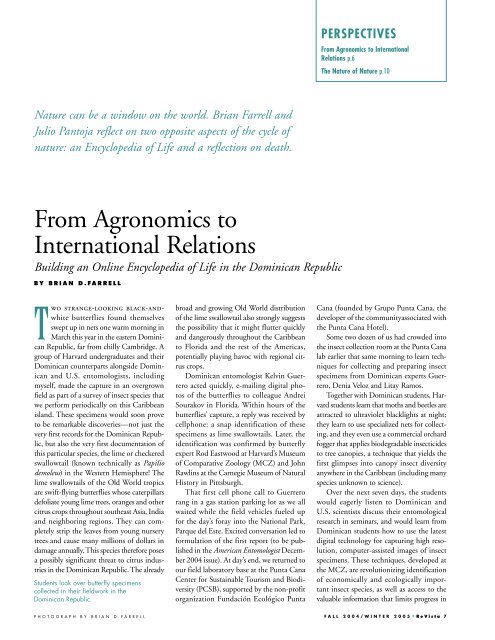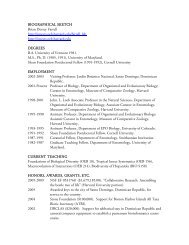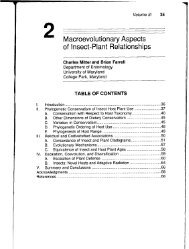Flora and Fauna - Harvard University
Flora and Fauna - Harvard University
Flora and Fauna - Harvard University
Create successful ePaper yourself
Turn your PDF publications into a flip-book with our unique Google optimized e-Paper software.
PERSPECTIVES<br />
From Agronomics to International<br />
Relations p.6<br />
The Nature of Nature p.10<br />
Nature can be a window on the world. Brian Farrell <strong>and</strong><br />
Julio Pantoja reflect on two opposite aspects of the cycle of<br />
nature: an Encyclopedia of Life <strong>and</strong> a reflection on death.<br />
From Agronomics to<br />
International Relations<br />
Building an Online Encyclopedia of Life in the Dominican Republic<br />
B Y B R I A N D . F A R R E L L<br />
TWO STRANGE-LOOKING BLACK-ANDwhite<br />
butterflies found themselves<br />
swept up in nets one warm morning in<br />
March this year in the eastern Dominican<br />
Republic, far from chilly Cambridge. A<br />
group of <strong>Harvard</strong> undergraduates <strong>and</strong> their<br />
Dominican counterparts alongside Dominican<br />
<strong>and</strong> U.S. entomologists, including<br />
myself, made the capture in an overgrown<br />
field as part of a survey of insect species that<br />
we perform periodically on this Caribbean<br />
isl<strong>and</strong>. These specimens would soon prove<br />
to be remarkable discoveries—not just the<br />
very first records for the Dominican Republic,<br />
but also the very first documentation of<br />
this particular species, the lime or checkered<br />
swallowtail (known technically as Papilio<br />
demoleus) in the Western Hemisphere! The<br />
lime swallowtails of the Old World tropics<br />
are swift-flying butterflies whose caterpillars<br />
defoliate young lime trees, oranges <strong>and</strong> other<br />
citrus crops throughout southeast Asia, India<br />
<strong>and</strong> neighboring regions. They can completely<br />
strip the leaves from young nursery<br />
trees <strong>and</strong> cause many millions of dollars in<br />
damage annually. This species therefore poses<br />
a possibly significant threat to citrus industries<br />
in the Dominican Republic. The already<br />
Students look over butterfly specimens<br />
collected in their fieldwork in the<br />
Dominican Republic.<br />
broad <strong>and</strong> growing Old World distribution<br />
of the lime swallowtail also strongly suggests<br />
the possibility that it might flutter quickly<br />
<strong>and</strong> dangerously throughout the Caribbean<br />
to Florida <strong>and</strong> the rest of the Americas,<br />
potentially playing havoc with regional citrus<br />
crops.<br />
Dominican entomologist Kelvin Guerrero<br />
acted quickly, e-mailing digital photos<br />
of the butterflies to colleague Andrei<br />
Sourakov in Florida. Within hours of the<br />
butterflies’ capture, a reply was received by<br />
cellphone: a snap identification of these<br />
specimens as lime swallowtails. Later, the<br />
identification was confirmed by butterfly<br />
expert Rod Eastwood at <strong>Harvard</strong>’s Museum<br />
of Comparative Zoology (MCZ) <strong>and</strong> John<br />
Rawlins at the Carnegie Museum of Natural<br />
History in Pittsburgh.<br />
That first cell phone call to Guerrero<br />
rang in a gas station parking lot as we all<br />
waited while the field vehicles fueled up<br />
for the day’s foray into the National Park,<br />
Parque del Este. Excited conversation led to<br />
formulation of the first report (to be published<br />
in the American Entomologist December<br />
2004 issue). At day’s end, we returned to<br />
our field laboratory base at the Punta Cana<br />
Center for Sustainable Tourism <strong>and</strong> Biodiversity<br />
(PCSB), supported by the non-profit<br />
organization Fundación Ecológico Punta<br />
Cana (founded by Grupo Punta Cana, the<br />
developer of the communityassociated with<br />
the Punta Cana Hotel).<br />
Some two dozen of us had crowded into<br />
the insect collection room at the Punta Cana<br />
lab earlier that same morning to learn techniques<br />
for collecting <strong>and</strong> preparing insect<br />
specimens from Dominican experts Guerrero,<br />
Denia Veloz <strong>and</strong> Litay Ramos.<br />
Together with Dominican students, <strong>Harvard</strong><br />
students learn that moths <strong>and</strong> beetles are<br />
attracted to ultraviolet blacklights at night;<br />
they learn to use specialized nets for collecting,<br />
<strong>and</strong> they even use a commercial orchard<br />
fogger that applies biodegradable insecticides<br />
to tree canopies, a technique that yields the<br />
first glimpses into canopy insect diversity<br />
anywhere in the Caribbean (including many<br />
species unknown to science).<br />
Over the next seven days, the students<br />
would eagerly listen to Dominican <strong>and</strong><br />
U.S. scientists discuss their entomological<br />
research in seminars, <strong>and</strong> would learn from<br />
Dominican students how to use the latest<br />
digital technology for capturing high resolution,<br />
computer-assisted images of insect<br />
specimens. These techniques, developed at<br />
the MCZ, are revolutionizing identification<br />
of economically <strong>and</strong> ecologically important<br />
insect species, as well as access to the<br />
valuable information that limits progress in<br />
P H O T O G R A P H B Y B R I A N D . F A R R E L L<br />
F A L L 2 0 0 4 / W I N T E R 2 0 0 5 • R e V i s t a 7




